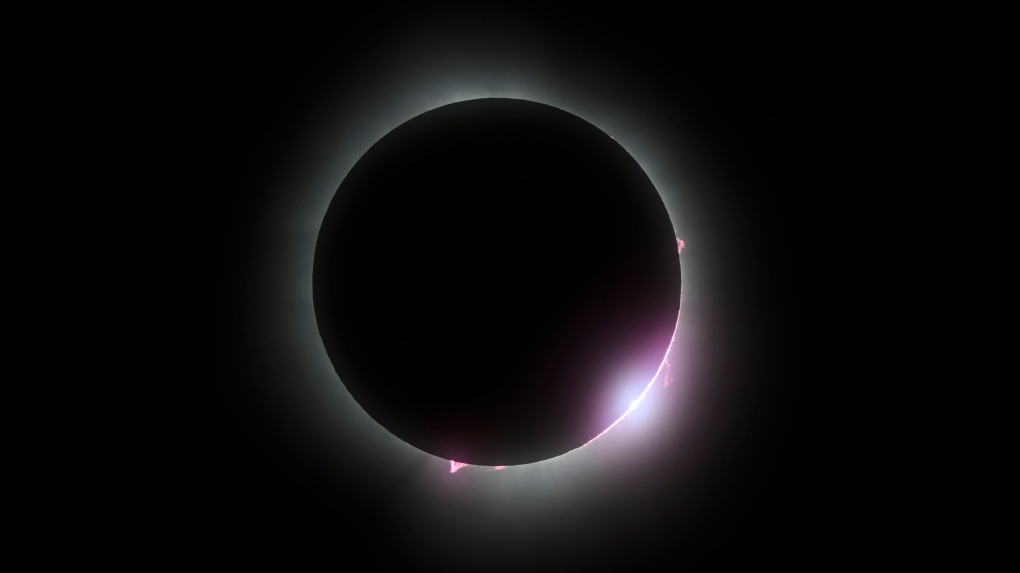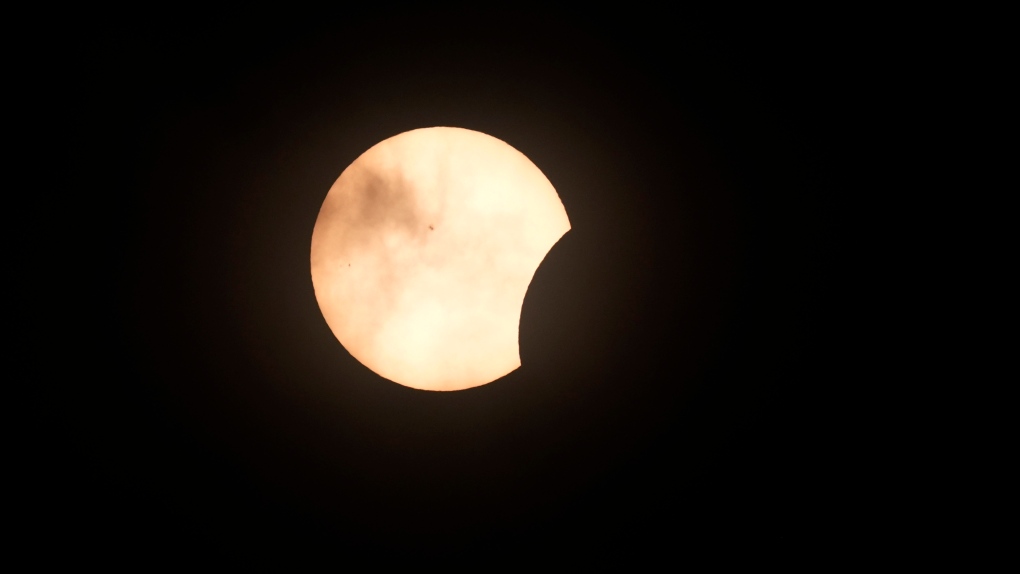‘Like magic’: Total solar eclipse moves across parts of Canada, crowds in awe
NIAGARA FALLS and TORONTO –
Earth-bound audiences turned skyward as the sun moved directly behind the moon on Monday, plunging parts of Canada into the darkness of a total solar eclipse and a moment of shared celestial awe.
Eclipse watchers in southwestern Ontario were the first on Canadian soil to experience the eclipse, before the path of totality moved into Quebec and Atlantic Canada, exiting Newfoundland about 30 minutes later.
Temperatures dipped, animals quieted, and rapturous crowds watched as the sun’s corona came into view behind the black disc of the moon. Stars lit up the darkened skies and streetlights went on for a short period of time.
Hilding Neilson was emotional and struggling for words as the sun reappeared and soaked Gander, N.L., in its light.
“It was just remarkable, just an amazing experience,” said Neilson, a Memorial University astrophysicist who made the trip from St. John’s with some students.
“Just before totality, feeling it get darker, we felt the temperature drop … it was just amazing to see the darkness.”
While the next total solar eclipse in Canada is expected to pass through western provinces in 20 years, the phenomenon only happens in any given location roughly once every 360 years by some estimates.
Some areas have waited even longer.
Crowds in Kingston, Ont., which last fell under a total solar eclipse almost 700 years ago, cheered and howled as totality moved in. Volunteers hastily told people to put their eclipse glasses back on as the sun reemerged.
 A diamond ring effect is seen during the totality phase of a total solar eclipse, in Kingston, Ont., Monday, April 8, 2024. THE CANADIAN PRESS/Justin Tang
A diamond ring effect is seen during the totality phase of a total solar eclipse, in Kingston, Ont., Monday, April 8, 2024. THE CANADIAN PRESS/Justin Tang
“You feel like you’re part of the universe in motion,” said Carole Giangrande. “There’s no human experience that can match it.”
Giangrande and Brian Gibson have been chasing solar eclipses for 45 years, their first dating back to Gimli, Manitoba, in 1979. But the Toronto couple said the chance to capture a solar eclipse never goes out of style.
“So much in the world right now is so rotten, it gives you such a feeling of positivity and people enjoying themselves, and wonder,” Giangrande said of watching an eclipse. “It’s beautiful.”
In Niagara Falls, Ont., 58-year-old Norma Rois was met with cheers when she yelled that it was her birthday during a moment of the totality.
“I felt like I was with family members the whole time. I don’t know their names, but we were cheering together,” she said.
This celestial dance, in which the moon, the sun and the Earth align, is possible thanks to some miraculous stage setting. The moon is about 400 times smaller than the sun, but it’s also about 400 times closer to the Earth – making both appear to be the same size in the sky.
Astronaut David Saint-Jacques said it’s one of the rare times we have a “direct connection with what’s going on in space.”
“It’s a very direct reminder of the reality of the cosmic ballet, if you want, that’s constantly going on,” said Saint-Jacques, who was part of a 204-day mission to the International Space Station starting in 2018, the longest Canadian mission to date.
“I think that’s the magic of it – it’s the connection with the cosmos.”
 The beginning of a solar eclipse, as seen from Fort Worth, Texas, Monday, April 8, 2024. (AP Photo/LM Otero)
The beginning of a solar eclipse, as seen from Fort Worth, Texas, Monday, April 8, 2024. (AP Photo/LM Otero)
In Fredericton, some cheered, others clapped, several swore and yet others screamed as a piece of cloud blocking the sun moved away just in time for the moment of totality.
“It was so cool and awesome. It was amazing,” said five-year-old Lucy Hall.
Kathy Eller of O’Leary, P.E.I., had no regrets after waiting outside for six hours to take in the total eclipse near the province’s northwestern tip.
“It was better than fireworks,” she said. “I forgot about everybody around, and was just concentrating on the sun and the moon. It was kind of like magic.”
Astronomy educator Julie Bolduc-Duval said the eclipse offered people the chance to set aside divisions for a moment together under the shadow of the moon.
“It really makes you realize where you are in the universe,” said Bolduc-Duval, director of Discover the Universe, offered in part by the Dunlap Institute for Astronomy and Astrophysics at the University of Toronto.
One in six people live in Canada’s path of totality for Monday’s eclipse, or about 6.1 million people based on 2021 census data, said Statistics Canada, noting the number is likely higher given rapid population growth.
Those outside the path of totality still took in the partial eclipse.
Office workers flooded Toronto sidewalks lit by streetlights and at least one criminal trial took a pause as the skies darkened. In Ottawa, some parliamentary business came to a halt as people exchanged eclipse glasses outside the Library and Archives building.
Total solar eclipses have been central to some major scientific breakthroughs.
Helium was detected for the first time during an 1868 eclipse, and observations made during one in 1919 helped establish broad support for Albert Einstein’s general theory of relativity.
– with files from Mickey Djuric in Kingston, Ont., Morgan Lowrie in Montreal, Hina Alam in Fredericton and Sarah Smellie in Gander, N.L.
View original article here Source









